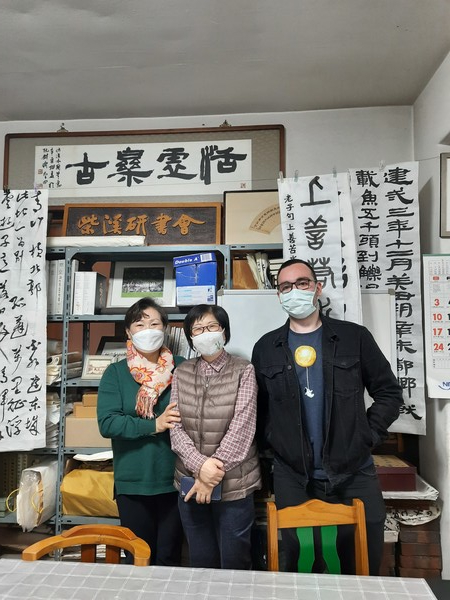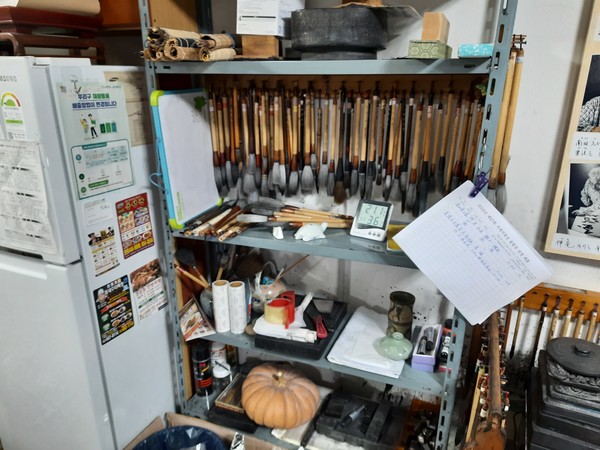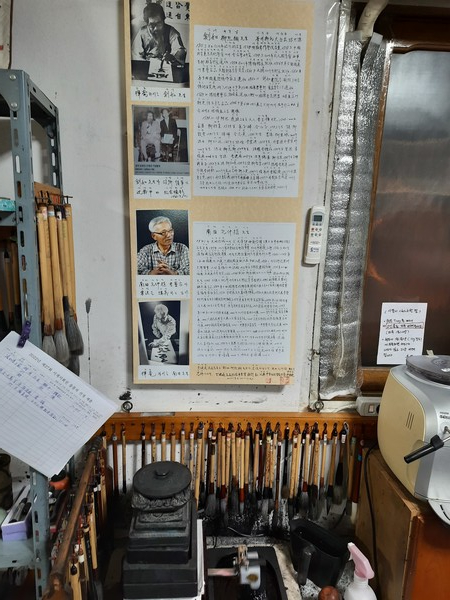The University of Seoul (UOS) guarantees a variety of club activities to strengthen friendship between students, broaden university culture, and promote healthy and reasonable in-school and extracurricular activities. There are six divisions of UOS student clubs: Performance/Culture, Liberal Arts, Religion, Physical Activity, Academic Humanities, and Academic Social Sciences. All students are free to join or withdraw from any club during their activities. Students are free to attend all kinds of club activities, but cannot officially be registered with more than one club, although some clubs may allow unofficial double membership.
The UOS Times visited a Korean calligraphy club, “Yeonmukhoe,” to see what students do as members of the club. Normally Yeonmukhoe has had the most spacious workshop of all the clubs, but because of the renovation of the Student Hall, the club now holds its activities in its teachers’ workshop, which is an hour away from campus. The club recruited its new members in the first week of April, allowing The UOS Times to observe what new members do in their first lesson. First, they drew straight lines to get used to the technique and learn the basics of how to hold and use the brush. To find out more about the art and the club, The UOS Times interviewed teacher Kim In-sug, Student A, who has been in the club for 3 years, and Student B, who is a freshman.

Q1: Please introduce yourself and Korean calligraphy to our readers.
Teacher Kim: Hello, I am teacher Kim In-sug of Yeonmukhoe Club. I have been learning Korean calligraphy for 38 years and I have been teaching Korean calligraphy in the Yeonmukhoe Club for three years now. Holding the brush and having a deep connection with it are the most crucial elements of writing. Having a brush as a tool is not enough to write well in calligraphy. It needs to become a part of one’s body. Each person has a different way of thinking and different way of connection with the brush, so it creates the perfect environment to express one’s thoughts freely. By looking at a Hanja character, one may see it as a tree, while another may see it as the root of a plant. In other words, Korean calligraphy is a journey through which, by taking it, people can discover inner peace and their true selves.
Q2: What is the main motivation for learning Korean calligraphy?
Teacher Kim: Learning calligraphy is a journey that never ends. It becomes one’s partner in life by helping one to relieve stress, empty one’s mind, and help one to focus and meet people with the same interests. It also helps people to understand art, ways of life, nature, and many other things. When learning calligraphy, one starts to ask about ways of symbolizing things, people’s names and their meanings, and many other questions that one never asked before. It helps people to become perfect observers as well. Writing itself is a very charming activity. After figuring out how to use one’s brush, one enters the most productive time of writing because one can then unleash one’s curiosity onto paper, which results in writing calligraphy constantly, day after day. There is also a calligraphy exhibition in the Centennial Memorial Hall every year and some competitions that help us to find the motions of this particular art.
If one is interested in Korean history or Korean literature, being able to read and write Hanja is crucial to proceed further. Therefore, calligraphy can become a hobby that helps one to learn about Korean literature, the Korean way of thinking, and Korean culture.
Student A: I have been learning calligraphy for over 20 years and it has been 3 years since I started attending this club. I love learning calligraphy and I love writing, but the most important part of this club is that it is a place where many good people attend. It gives me a great motivation to continue learning calligraphy, and we eat, drink, study, and even have MTs to all have a great time together.

Q3: How does the club change a person’s life?
Teacher Kim: Learning calligraphy changes peoples’ philosophy. It makes people humbler and helps make people more patient while providing them with a more artistic way of thinking. The club itself also becomes a place where students meet new friends who have the same interests.
Student A: Calligraphy is an art that requires great time, patience, and desire to continue. Hanging out with people who do not give up easily makes this club feel like a family. People help each other out whenever they need, and in return that makes them more connected to the club. I have made many great friends thanks to the club, and I have had so many unforgettable memories.

Q4: Do you think calligraphy is an entertaining art to do?
Teacher Kim: It depends on the definition of “entertainment.” Calligraphy is not an art to have fun with. However, if one is interested in it, it becomes a very intriguing art to practice. One may spend hours doing calligraphy without realizing it. It makes people’s hearts flutter and gives a special type of joy that can be felt after working hard.
Student A: To be honest, it is hard to learn in the beginning, but people learn a lot as they practice, and if you have a curious personality, the process itself will be enjoyable. I recommend that people endure the hardship for the first one to two months because it will get easier and much more interesting afterwards.
Student B: It is harder than I thought because it requires so much patience and concentration, but at the same time it makes me happy while I am doing it. I like to talk and hang out with the seniors. I also love this club because it is a place where one needs to attend for a long time to accomplish something. It keeps me passionate to learn and practice more.

Yeonmukhoe Club has a long history of more than 20 years since it was founded with about 20 active members. From teachers to students, everyone in the club is very welcoming toward other people. Club members also see each other outside of the club as well. They go out and spend time together doing various social activities, such as going on MT or eating dinner together. Anyone can join the club and everyone in the club is eager to help beginners, but it is also best to be aware of its hardships before joining the club.



